Organisational Structure and Culture: A Microsoft Case Study
VerifiedAdded on 2023/06/14
|10
|2671
|136
Report
AI Summary
This report analyses Microsoft's organisational structure and culture, focusing on the factors that influence its structure, such as strategy, organisational size, technology, and environment. It identifies key characteristics of Microsoft's organisational structure, including clear lines of authority, adequate delegation, fewer managerial levels, proper span of control, and flexibility. The report also explains how Microsoft manages dynamic processes that shape its growth and evolution, highlighting the ADKAR model (Awareness, Desire, Knowledge, Ability, Reinforcement) as a key change management strategy. The analysis concludes that a well-defined organisational structure is crucial for guiding employees, defining roles, and achieving business objectives, with Microsoft's approach serving as a practical example.
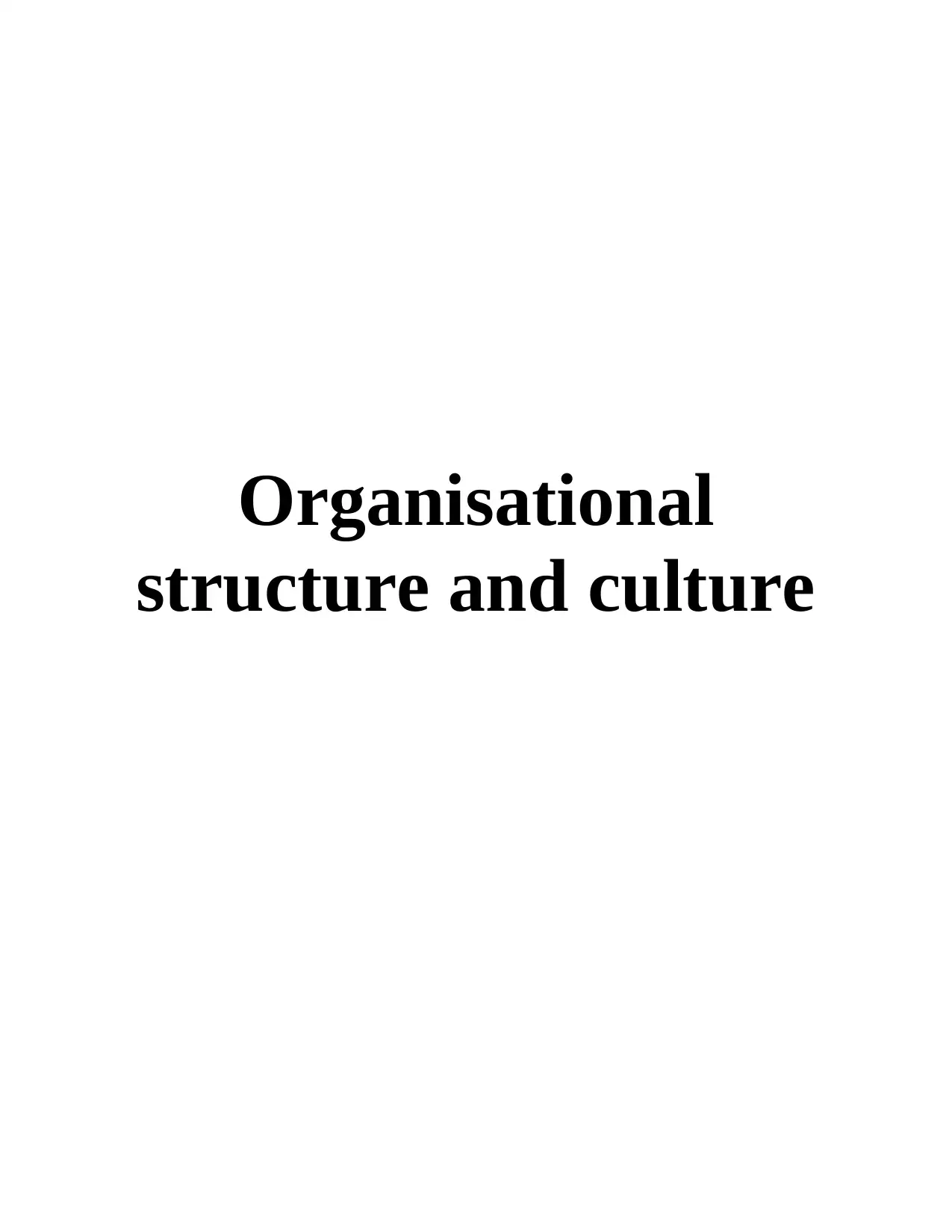
Organisational
structure and culture
structure and culture
Paraphrase This Document
Need a fresh take? Get an instant paraphrase of this document with our AI Paraphraser
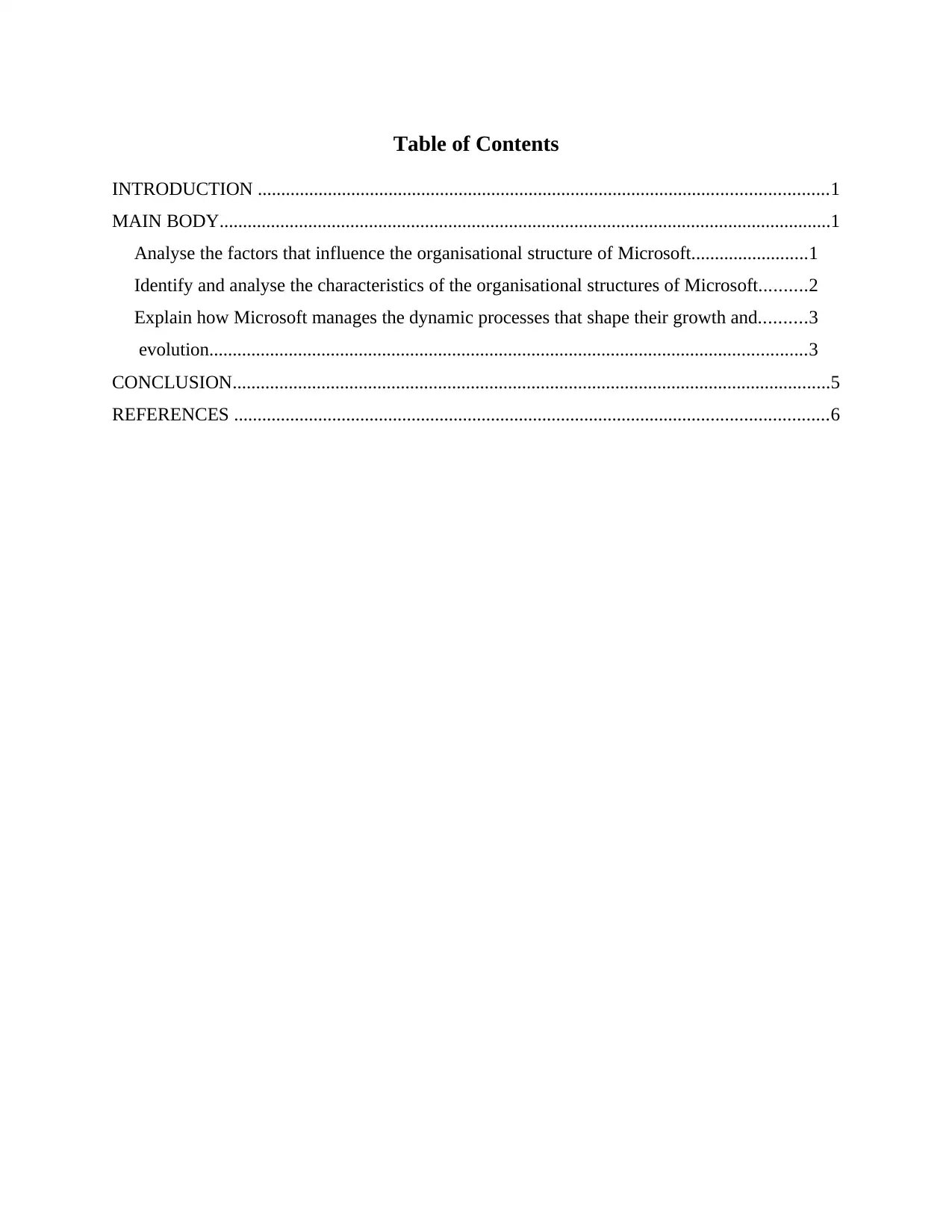
Table of Contents
INTRODUCTION ..........................................................................................................................1
MAIN BODY...................................................................................................................................1
Analyse the factors that influence the organisational structure of Microsoft.........................1
Identify and analyse the characteristics of the organisational structures of Microsoft..........2
Explain how Microsoft manages the dynamic processes that shape their growth and..........3
evolution................................................................................................................................3
CONCLUSION................................................................................................................................5
REFERENCES ...............................................................................................................................6
INTRODUCTION ..........................................................................................................................1
MAIN BODY...................................................................................................................................1
Analyse the factors that influence the organisational structure of Microsoft.........................1
Identify and analyse the characteristics of the organisational structures of Microsoft..........2
Explain how Microsoft manages the dynamic processes that shape their growth and..........3
evolution................................................................................................................................3
CONCLUSION................................................................................................................................5
REFERENCES ...............................................................................................................................6
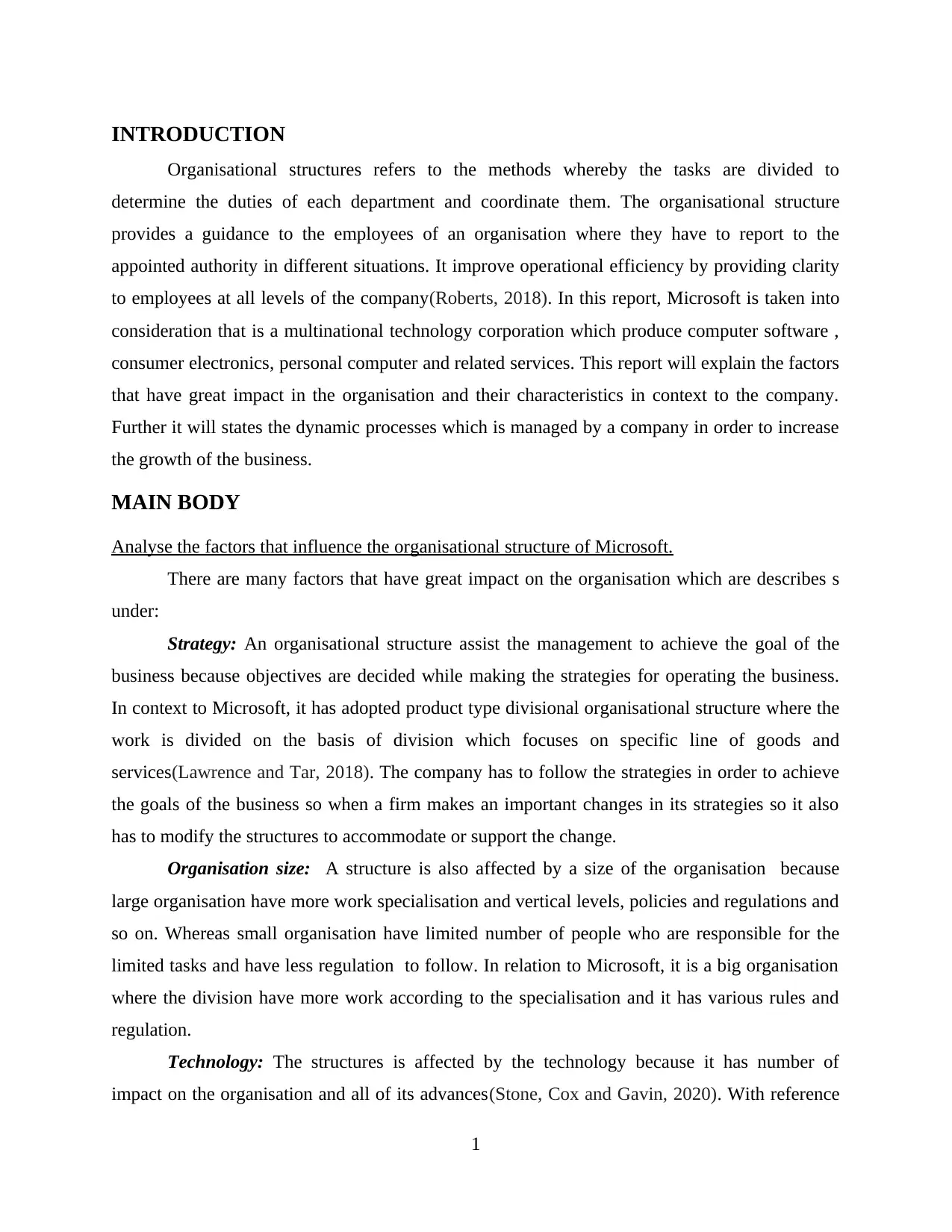
INTRODUCTION
Organisational structures refers to the methods whereby the tasks are divided to
determine the duties of each department and coordinate them. The organisational structure
provides a guidance to the employees of an organisation where they have to report to the
appointed authority in different situations. It improve operational efficiency by providing clarity
to employees at all levels of the company(Roberts, 2018). In this report, Microsoft is taken into
consideration that is a multinational technology corporation which produce computer software ,
consumer electronics, personal computer and related services. This report will explain the factors
that have great impact in the organisation and their characteristics in context to the company.
Further it will states the dynamic processes which is managed by a company in order to increase
the growth of the business.
MAIN BODY
Analyse the factors that influence the organisational structure of Microsoft.
There are many factors that have great impact on the organisation which are describes s
under:
Strategy: An organisational structure assist the management to achieve the goal of the
business because objectives are decided while making the strategies for operating the business.
In context to Microsoft, it has adopted product type divisional organisational structure where the
work is divided on the basis of division which focuses on specific line of goods and
services(Lawrence and Tar, 2018). The company has to follow the strategies in order to achieve
the goals of the business so when a firm makes an important changes in its strategies so it also
has to modify the structures to accommodate or support the change.
Organisation size: A structure is also affected by a size of the organisation because
large organisation have more work specialisation and vertical levels, policies and regulations and
so on. Whereas small organisation have limited number of people who are responsible for the
limited tasks and have less regulation to follow. In relation to Microsoft, it is a big organisation
where the division have more work according to the specialisation and it has various rules and
regulation.
Technology: The structures is affected by the technology because it has number of
impact on the organisation and all of its advances(Stone, Cox and Gavin, 2020). With reference
1
Organisational structures refers to the methods whereby the tasks are divided to
determine the duties of each department and coordinate them. The organisational structure
provides a guidance to the employees of an organisation where they have to report to the
appointed authority in different situations. It improve operational efficiency by providing clarity
to employees at all levels of the company(Roberts, 2018). In this report, Microsoft is taken into
consideration that is a multinational technology corporation which produce computer software ,
consumer electronics, personal computer and related services. This report will explain the factors
that have great impact in the organisation and their characteristics in context to the company.
Further it will states the dynamic processes which is managed by a company in order to increase
the growth of the business.
MAIN BODY
Analyse the factors that influence the organisational structure of Microsoft.
There are many factors that have great impact on the organisation which are describes s
under:
Strategy: An organisational structure assist the management to achieve the goal of the
business because objectives are decided while making the strategies for operating the business.
In context to Microsoft, it has adopted product type divisional organisational structure where the
work is divided on the basis of division which focuses on specific line of goods and
services(Lawrence and Tar, 2018). The company has to follow the strategies in order to achieve
the goals of the business so when a firm makes an important changes in its strategies so it also
has to modify the structures to accommodate or support the change.
Organisation size: A structure is also affected by a size of the organisation because
large organisation have more work specialisation and vertical levels, policies and regulations and
so on. Whereas small organisation have limited number of people who are responsible for the
limited tasks and have less regulation to follow. In relation to Microsoft, it is a big organisation
where the division have more work according to the specialisation and it has various rules and
regulation.
Technology: The structures is affected by the technology because it has number of
impact on the organisation and all of its advances(Stone, Cox and Gavin, 2020). With reference
1
⊘ This is a preview!⊘
Do you want full access?
Subscribe today to unlock all pages.

Trusted by 1+ million students worldwide
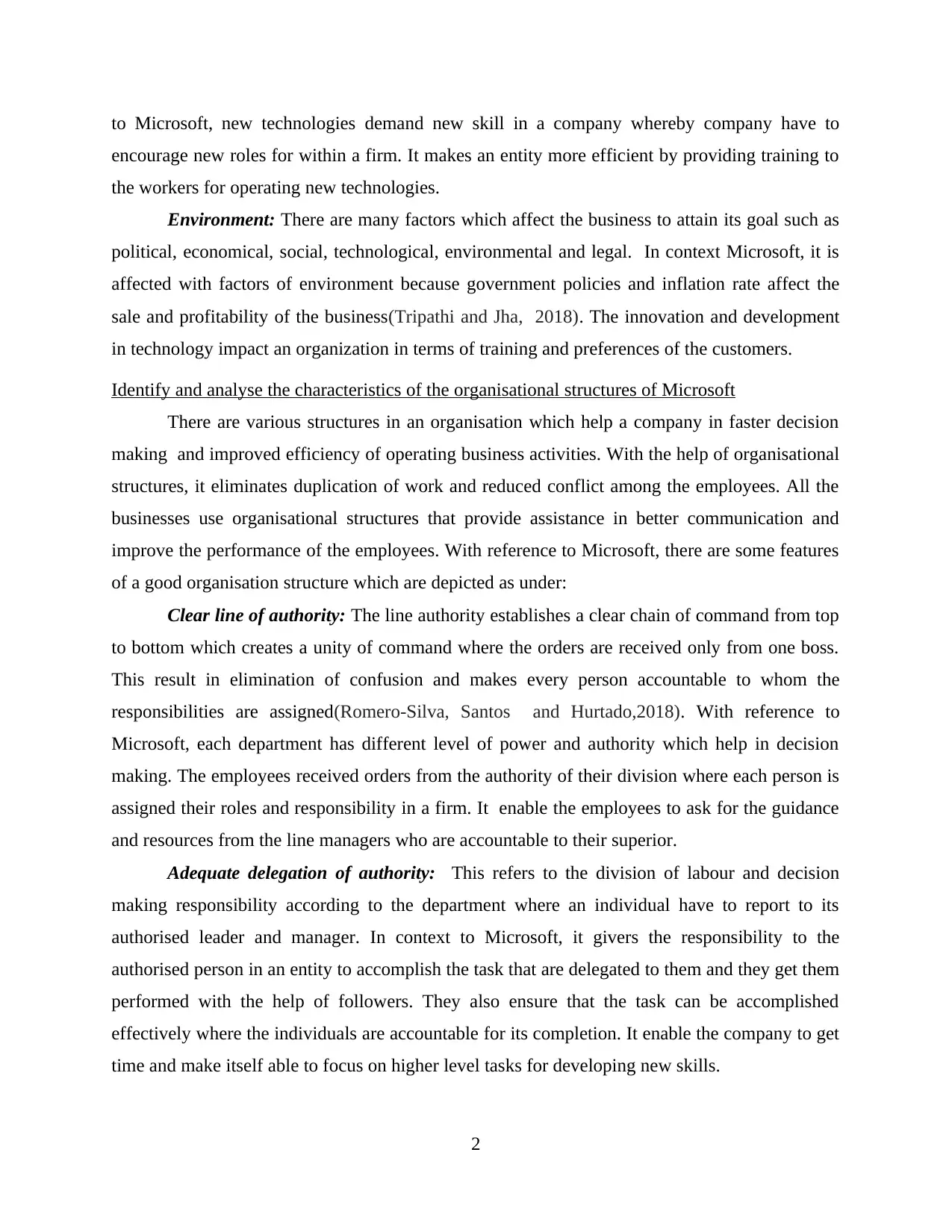
to Microsoft, new technologies demand new skill in a company whereby company have to
encourage new roles for within a firm. It makes an entity more efficient by providing training to
the workers for operating new technologies.
Environment: There are many factors which affect the business to attain its goal such as
political, economical, social, technological, environmental and legal. In context Microsoft, it is
affected with factors of environment because government policies and inflation rate affect the
sale and profitability of the business(Tripathi and Jha, 2018). The innovation and development
in technology impact an organization in terms of training and preferences of the customers.
Identify and analyse the characteristics of the organisational structures of Microsoft
There are various structures in an organisation which help a company in faster decision
making and improved efficiency of operating business activities. With the help of organisational
structures, it eliminates duplication of work and reduced conflict among the employees. All the
businesses use organisational structures that provide assistance in better communication and
improve the performance of the employees. With reference to Microsoft, there are some features
of a good organisation structure which are depicted as under:
Clear line of authority: The line authority establishes a clear chain of command from top
to bottom which creates a unity of command where the orders are received only from one boss.
This result in elimination of confusion and makes every person accountable to whom the
responsibilities are assigned(Romero-Silva, Santos and Hurtado,2018). With reference to
Microsoft, each department has different level of power and authority which help in decision
making. The employees received orders from the authority of their division where each person is
assigned their roles and responsibility in a firm. It enable the employees to ask for the guidance
and resources from the line managers who are accountable to their superior.
Adequate delegation of authority: This refers to the division of labour and decision
making responsibility according to the department where an individual have to report to its
authorised leader and manager. In context to Microsoft, it givers the responsibility to the
authorised person in an entity to accomplish the task that are delegated to them and they get them
performed with the help of followers. They also ensure that the task can be accomplished
effectively where the individuals are accountable for its completion. It enable the company to get
time and make itself able to focus on higher level tasks for developing new skills.
2
encourage new roles for within a firm. It makes an entity more efficient by providing training to
the workers for operating new technologies.
Environment: There are many factors which affect the business to attain its goal such as
political, economical, social, technological, environmental and legal. In context Microsoft, it is
affected with factors of environment because government policies and inflation rate affect the
sale and profitability of the business(Tripathi and Jha, 2018). The innovation and development
in technology impact an organization in terms of training and preferences of the customers.
Identify and analyse the characteristics of the organisational structures of Microsoft
There are various structures in an organisation which help a company in faster decision
making and improved efficiency of operating business activities. With the help of organisational
structures, it eliminates duplication of work and reduced conflict among the employees. All the
businesses use organisational structures that provide assistance in better communication and
improve the performance of the employees. With reference to Microsoft, there are some features
of a good organisation structure which are depicted as under:
Clear line of authority: The line authority establishes a clear chain of command from top
to bottom which creates a unity of command where the orders are received only from one boss.
This result in elimination of confusion and makes every person accountable to whom the
responsibilities are assigned(Romero-Silva, Santos and Hurtado,2018). With reference to
Microsoft, each department has different level of power and authority which help in decision
making. The employees received orders from the authority of their division where each person is
assigned their roles and responsibility in a firm. It enable the employees to ask for the guidance
and resources from the line managers who are accountable to their superior.
Adequate delegation of authority: This refers to the division of labour and decision
making responsibility according to the department where an individual have to report to its
authorised leader and manager. In context to Microsoft, it givers the responsibility to the
authorised person in an entity to accomplish the task that are delegated to them and they get them
performed with the help of followers. They also ensure that the task can be accomplished
effectively where the individuals are accountable for its completion. It enable the company to get
time and make itself able to focus on higher level tasks for developing new skills.
2
Paraphrase This Document
Need a fresh take? Get an instant paraphrase of this document with our AI Paraphraser
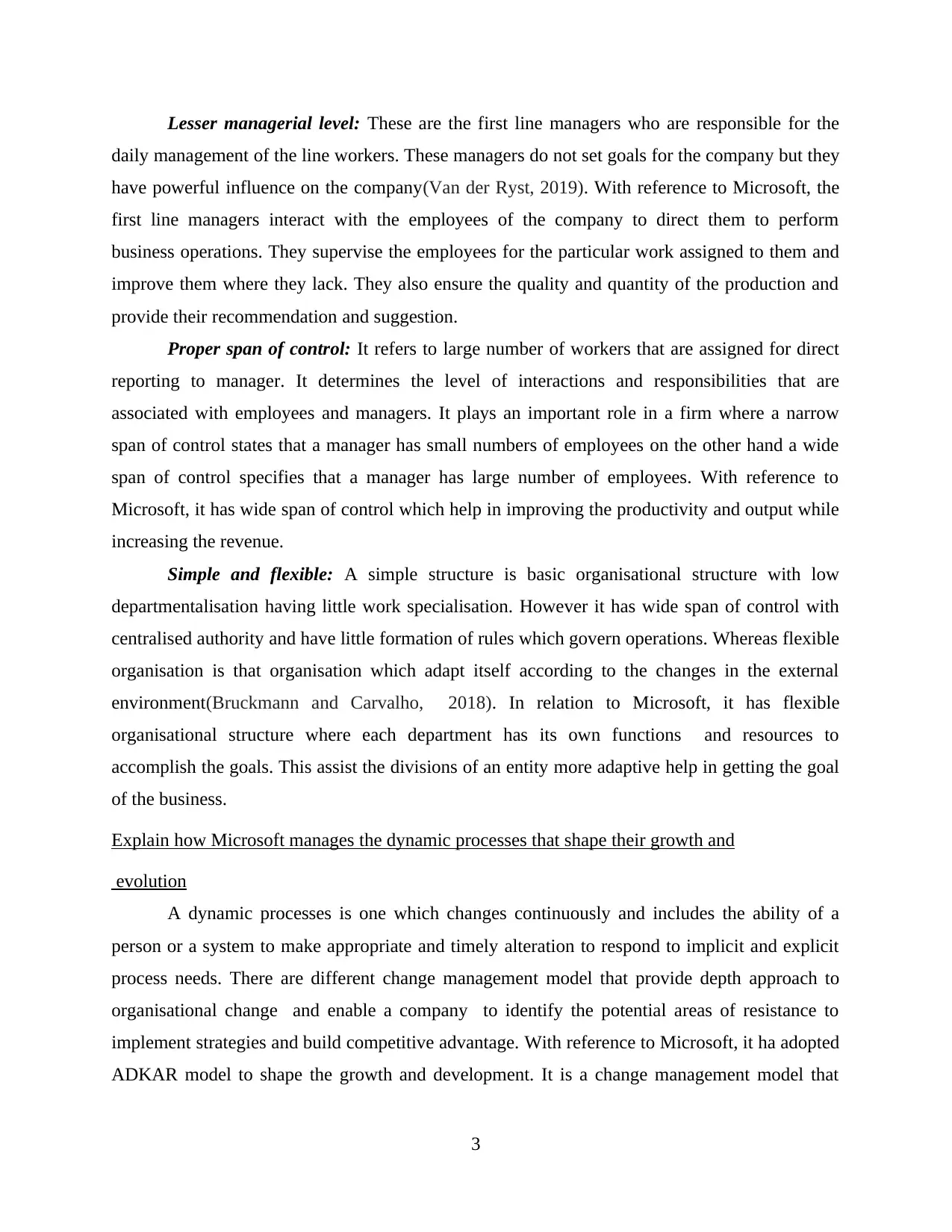
Lesser managerial level: These are the first line managers who are responsible for the
daily management of the line workers. These managers do not set goals for the company but they
have powerful influence on the company(Van der Ryst, 2019). With reference to Microsoft, the
first line managers interact with the employees of the company to direct them to perform
business operations. They supervise the employees for the particular work assigned to them and
improve them where they lack. They also ensure the quality and quantity of the production and
provide their recommendation and suggestion.
Proper span of control: It refers to large number of workers that are assigned for direct
reporting to manager. It determines the level of interactions and responsibilities that are
associated with employees and managers. It plays an important role in a firm where a narrow
span of control states that a manager has small numbers of employees on the other hand a wide
span of control specifies that a manager has large number of employees. With reference to
Microsoft, it has wide span of control which help in improving the productivity and output while
increasing the revenue.
Simple and flexible: A simple structure is basic organisational structure with low
departmentalisation having little work specialisation. However it has wide span of control with
centralised authority and have little formation of rules which govern operations. Whereas flexible
organisation is that organisation which adapt itself according to the changes in the external
environment(Bruckmann and Carvalho, 2018). In relation to Microsoft, it has flexible
organisational structure where each department has its own functions and resources to
accomplish the goals. This assist the divisions of an entity more adaptive help in getting the goal
of the business.
Explain how Microsoft manages the dynamic processes that shape their growth and
evolution
A dynamic processes is one which changes continuously and includes the ability of a
person or a system to make appropriate and timely alteration to respond to implicit and explicit
process needs. There are different change management model that provide depth approach to
organisational change and enable a company to identify the potential areas of resistance to
implement strategies and build competitive advantage. With reference to Microsoft, it ha adopted
ADKAR model to shape the growth and development. It is a change management model that
3
daily management of the line workers. These managers do not set goals for the company but they
have powerful influence on the company(Van der Ryst, 2019). With reference to Microsoft, the
first line managers interact with the employees of the company to direct them to perform
business operations. They supervise the employees for the particular work assigned to them and
improve them where they lack. They also ensure the quality and quantity of the production and
provide their recommendation and suggestion.
Proper span of control: It refers to large number of workers that are assigned for direct
reporting to manager. It determines the level of interactions and responsibilities that are
associated with employees and managers. It plays an important role in a firm where a narrow
span of control states that a manager has small numbers of employees on the other hand a wide
span of control specifies that a manager has large number of employees. With reference to
Microsoft, it has wide span of control which help in improving the productivity and output while
increasing the revenue.
Simple and flexible: A simple structure is basic organisational structure with low
departmentalisation having little work specialisation. However it has wide span of control with
centralised authority and have little formation of rules which govern operations. Whereas flexible
organisation is that organisation which adapt itself according to the changes in the external
environment(Bruckmann and Carvalho, 2018). In relation to Microsoft, it has flexible
organisational structure where each department has its own functions and resources to
accomplish the goals. This assist the divisions of an entity more adaptive help in getting the goal
of the business.
Explain how Microsoft manages the dynamic processes that shape their growth and
evolution
A dynamic processes is one which changes continuously and includes the ability of a
person or a system to make appropriate and timely alteration to respond to implicit and explicit
process needs. There are different change management model that provide depth approach to
organisational change and enable a company to identify the potential areas of resistance to
implement strategies and build competitive advantage. With reference to Microsoft, it ha adopted
ADKAR model to shape the growth and development. It is a change management model that
3
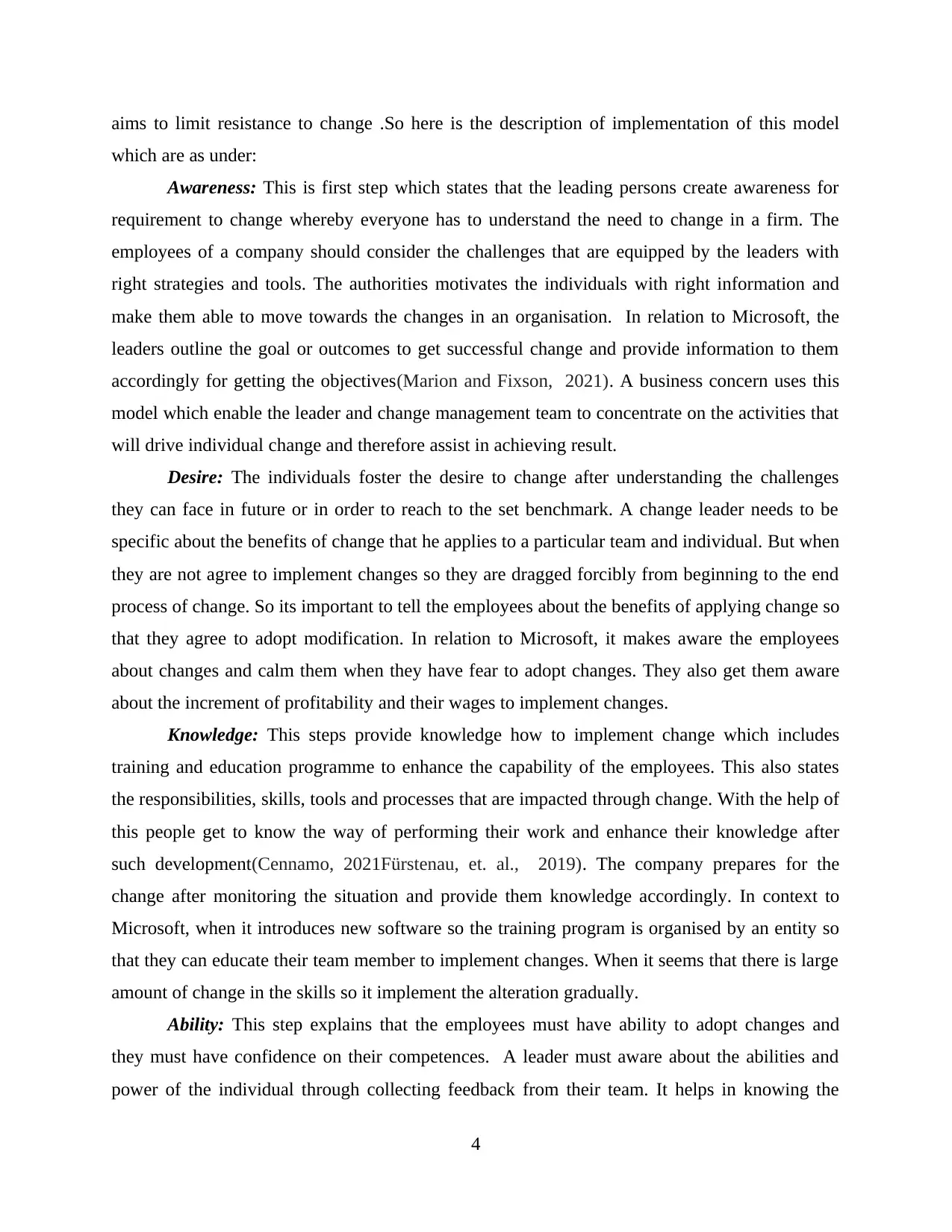
aims to limit resistance to change .So here is the description of implementation of this model
which are as under:
Awareness: This is first step which states that the leading persons create awareness for
requirement to change whereby everyone has to understand the need to change in a firm. The
employees of a company should consider the challenges that are equipped by the leaders with
right strategies and tools. The authorities motivates the individuals with right information and
make them able to move towards the changes in an organisation. In relation to Microsoft, the
leaders outline the goal or outcomes to get successful change and provide information to them
accordingly for getting the objectives(Marion and Fixson, 2021). A business concern uses this
model which enable the leader and change management team to concentrate on the activities that
will drive individual change and therefore assist in achieving result.
Desire: The individuals foster the desire to change after understanding the challenges
they can face in future or in order to reach to the set benchmark. A change leader needs to be
specific about the benefits of change that he applies to a particular team and individual. But when
they are not agree to implement changes so they are dragged forcibly from beginning to the end
process of change. So its important to tell the employees about the benefits of applying change so
that they agree to adopt modification. In relation to Microsoft, it makes aware the employees
about changes and calm them when they have fear to adopt changes. They also get them aware
about the increment of profitability and their wages to implement changes.
Knowledge: This steps provide knowledge how to implement change which includes
training and education programme to enhance the capability of the employees. This also states
the responsibilities, skills, tools and processes that are impacted through change. With the help of
this people get to know the way of performing their work and enhance their knowledge after
such development(Cennamo, 2021Fürstenau, et. al., 2019). The company prepares for the
change after monitoring the situation and provide them knowledge accordingly. In context to
Microsoft, when it introduces new software so the training program is organised by an entity so
that they can educate their team member to implement changes. When it seems that there is large
amount of change in the skills so it implement the alteration gradually.
Ability: This step explains that the employees must have ability to adopt changes and
they must have confidence on their competences. A leader must aware about the abilities and
power of the individual through collecting feedback from their team. It helps in knowing the
4
which are as under:
Awareness: This is first step which states that the leading persons create awareness for
requirement to change whereby everyone has to understand the need to change in a firm. The
employees of a company should consider the challenges that are equipped by the leaders with
right strategies and tools. The authorities motivates the individuals with right information and
make them able to move towards the changes in an organisation. In relation to Microsoft, the
leaders outline the goal or outcomes to get successful change and provide information to them
accordingly for getting the objectives(Marion and Fixson, 2021). A business concern uses this
model which enable the leader and change management team to concentrate on the activities that
will drive individual change and therefore assist in achieving result.
Desire: The individuals foster the desire to change after understanding the challenges
they can face in future or in order to reach to the set benchmark. A change leader needs to be
specific about the benefits of change that he applies to a particular team and individual. But when
they are not agree to implement changes so they are dragged forcibly from beginning to the end
process of change. So its important to tell the employees about the benefits of applying change so
that they agree to adopt modification. In relation to Microsoft, it makes aware the employees
about changes and calm them when they have fear to adopt changes. They also get them aware
about the increment of profitability and their wages to implement changes.
Knowledge: This steps provide knowledge how to implement change which includes
training and education programme to enhance the capability of the employees. This also states
the responsibilities, skills, tools and processes that are impacted through change. With the help of
this people get to know the way of performing their work and enhance their knowledge after
such development(Cennamo, 2021Fürstenau, et. al., 2019). The company prepares for the
change after monitoring the situation and provide them knowledge accordingly. In context to
Microsoft, when it introduces new software so the training program is organised by an entity so
that they can educate their team member to implement changes. When it seems that there is large
amount of change in the skills so it implement the alteration gradually.
Ability: This step explains that the employees must have ability to adopt changes and
they must have confidence on their competences. A leader must aware about the abilities and
power of the individual through collecting feedback from their team. It helps in knowing the
4
⊘ This is a preview!⊘
Do you want full access?
Subscribe today to unlock all pages.

Trusted by 1+ million students worldwide
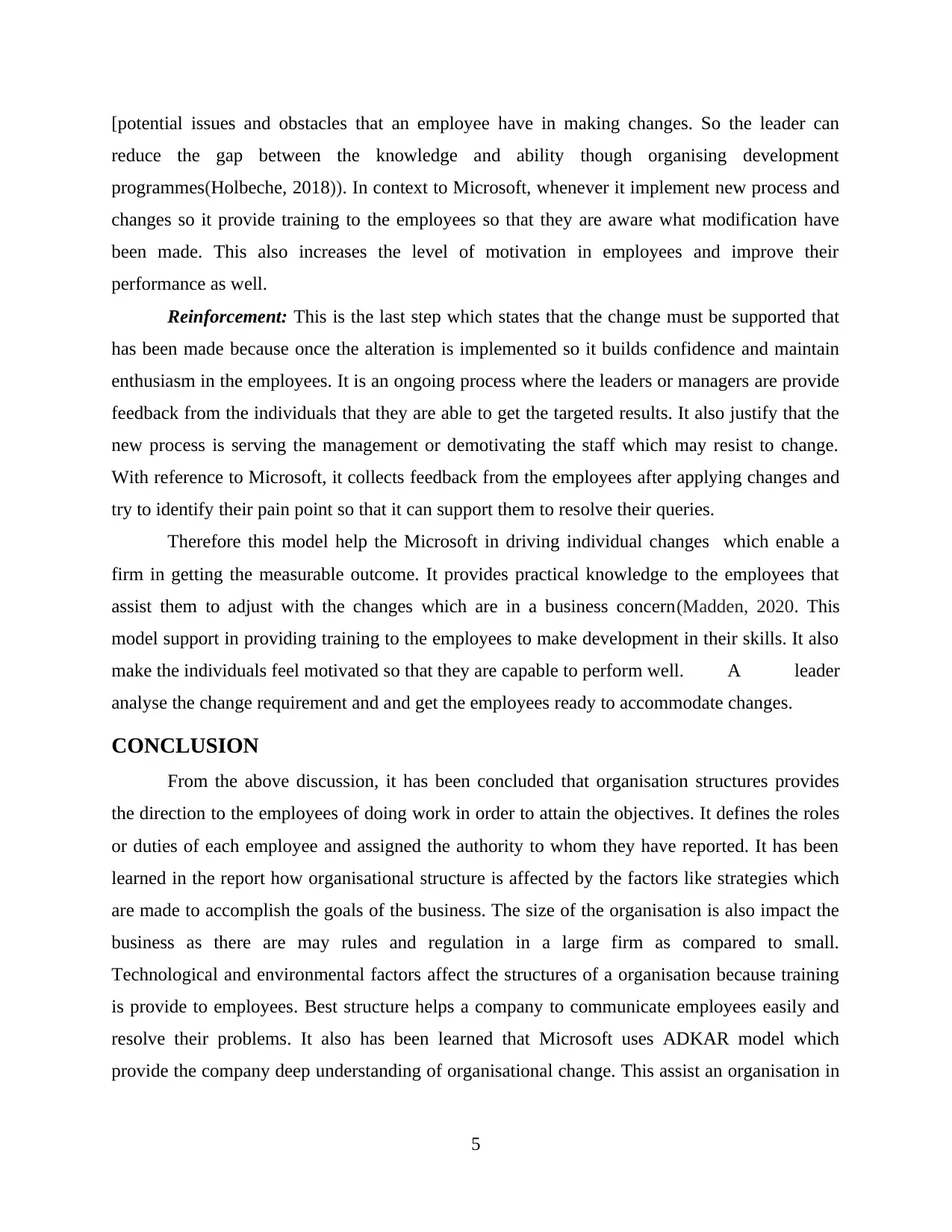
[potential issues and obstacles that an employee have in making changes. So the leader can
reduce the gap between the knowledge and ability though organising development
programmes(Holbeche, 2018)). In context to Microsoft, whenever it implement new process and
changes so it provide training to the employees so that they are aware what modification have
been made. This also increases the level of motivation in employees and improve their
performance as well.
Reinforcement: This is the last step which states that the change must be supported that
has been made because once the alteration is implemented so it builds confidence and maintain
enthusiasm in the employees. It is an ongoing process where the leaders or managers are provide
feedback from the individuals that they are able to get the targeted results. It also justify that the
new process is serving the management or demotivating the staff which may resist to change.
With reference to Microsoft, it collects feedback from the employees after applying changes and
try to identify their pain point so that it can support them to resolve their queries.
Therefore this model help the Microsoft in driving individual changes which enable a
firm in getting the measurable outcome. It provides practical knowledge to the employees that
assist them to adjust with the changes which are in a business concern(Madden, 2020. This
model support in providing training to the employees to make development in their skills. It also
make the individuals feel motivated so that they are capable to perform well. A leader
analyse the change requirement and and get the employees ready to accommodate changes.
CONCLUSION
From the above discussion, it has been concluded that organisation structures provides
the direction to the employees of doing work in order to attain the objectives. It defines the roles
or duties of each employee and assigned the authority to whom they have reported. It has been
learned in the report how organisational structure is affected by the factors like strategies which
are made to accomplish the goals of the business. The size of the organisation is also impact the
business as there are may rules and regulation in a large firm as compared to small.
Technological and environmental factors affect the structures of a organisation because training
is provide to employees. Best structure helps a company to communicate employees easily and
resolve their problems. It also has been learned that Microsoft uses ADKAR model which
provide the company deep understanding of organisational change. This assist an organisation in
5
reduce the gap between the knowledge and ability though organising development
programmes(Holbeche, 2018)). In context to Microsoft, whenever it implement new process and
changes so it provide training to the employees so that they are aware what modification have
been made. This also increases the level of motivation in employees and improve their
performance as well.
Reinforcement: This is the last step which states that the change must be supported that
has been made because once the alteration is implemented so it builds confidence and maintain
enthusiasm in the employees. It is an ongoing process where the leaders or managers are provide
feedback from the individuals that they are able to get the targeted results. It also justify that the
new process is serving the management or demotivating the staff which may resist to change.
With reference to Microsoft, it collects feedback from the employees after applying changes and
try to identify their pain point so that it can support them to resolve their queries.
Therefore this model help the Microsoft in driving individual changes which enable a
firm in getting the measurable outcome. It provides practical knowledge to the employees that
assist them to adjust with the changes which are in a business concern(Madden, 2020. This
model support in providing training to the employees to make development in their skills. It also
make the individuals feel motivated so that they are capable to perform well. A leader
analyse the change requirement and and get the employees ready to accommodate changes.
CONCLUSION
From the above discussion, it has been concluded that organisation structures provides
the direction to the employees of doing work in order to attain the objectives. It defines the roles
or duties of each employee and assigned the authority to whom they have reported. It has been
learned in the report how organisational structure is affected by the factors like strategies which
are made to accomplish the goals of the business. The size of the organisation is also impact the
business as there are may rules and regulation in a large firm as compared to small.
Technological and environmental factors affect the structures of a organisation because training
is provide to employees. Best structure helps a company to communicate employees easily and
resolve their problems. It also has been learned that Microsoft uses ADKAR model which
provide the company deep understanding of organisational change. This assist an organisation in
5
Paraphrase This Document
Need a fresh take? Get an instant paraphrase of this document with our AI Paraphraser
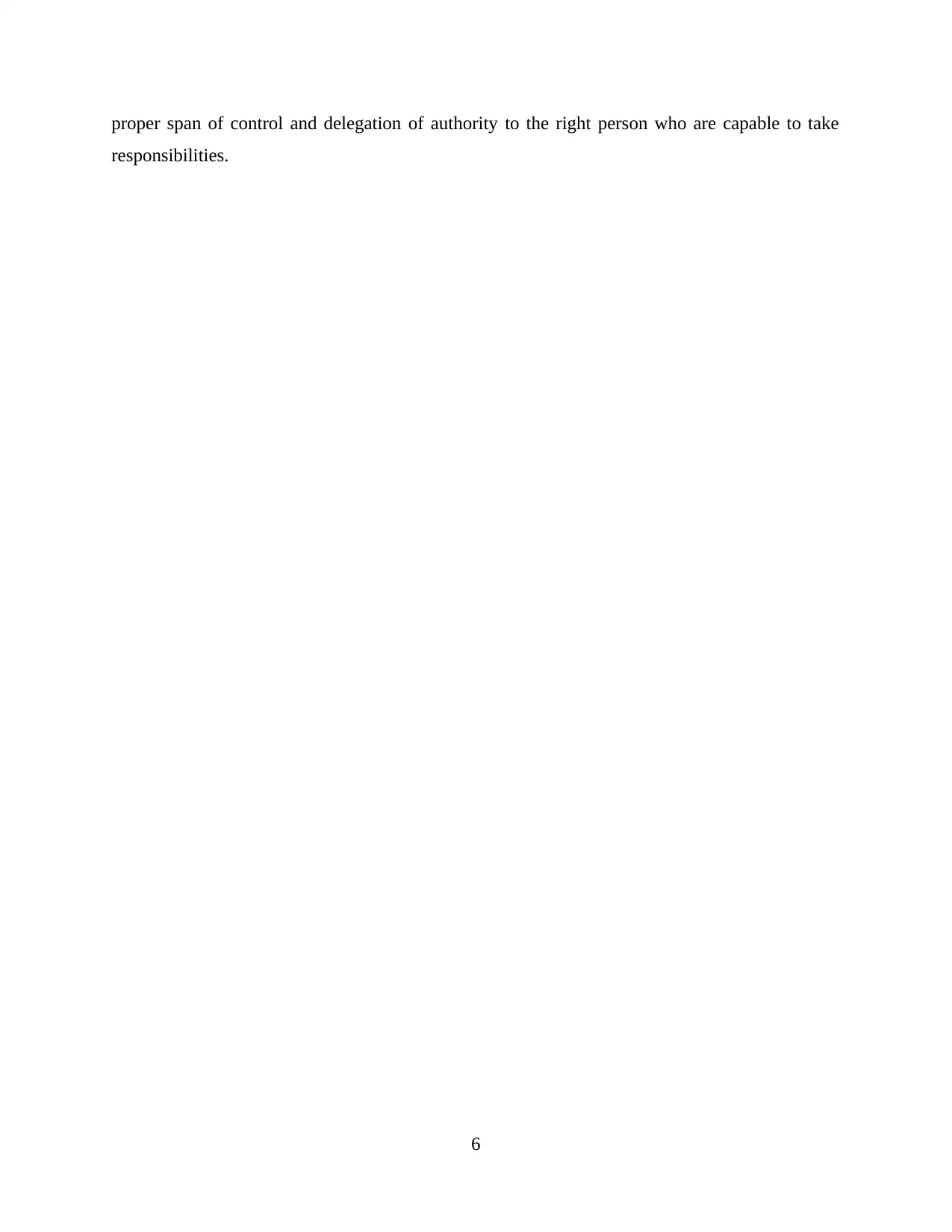
proper span of control and delegation of authority to the right person who are capable to take
responsibilities.
6
responsibilities.
6
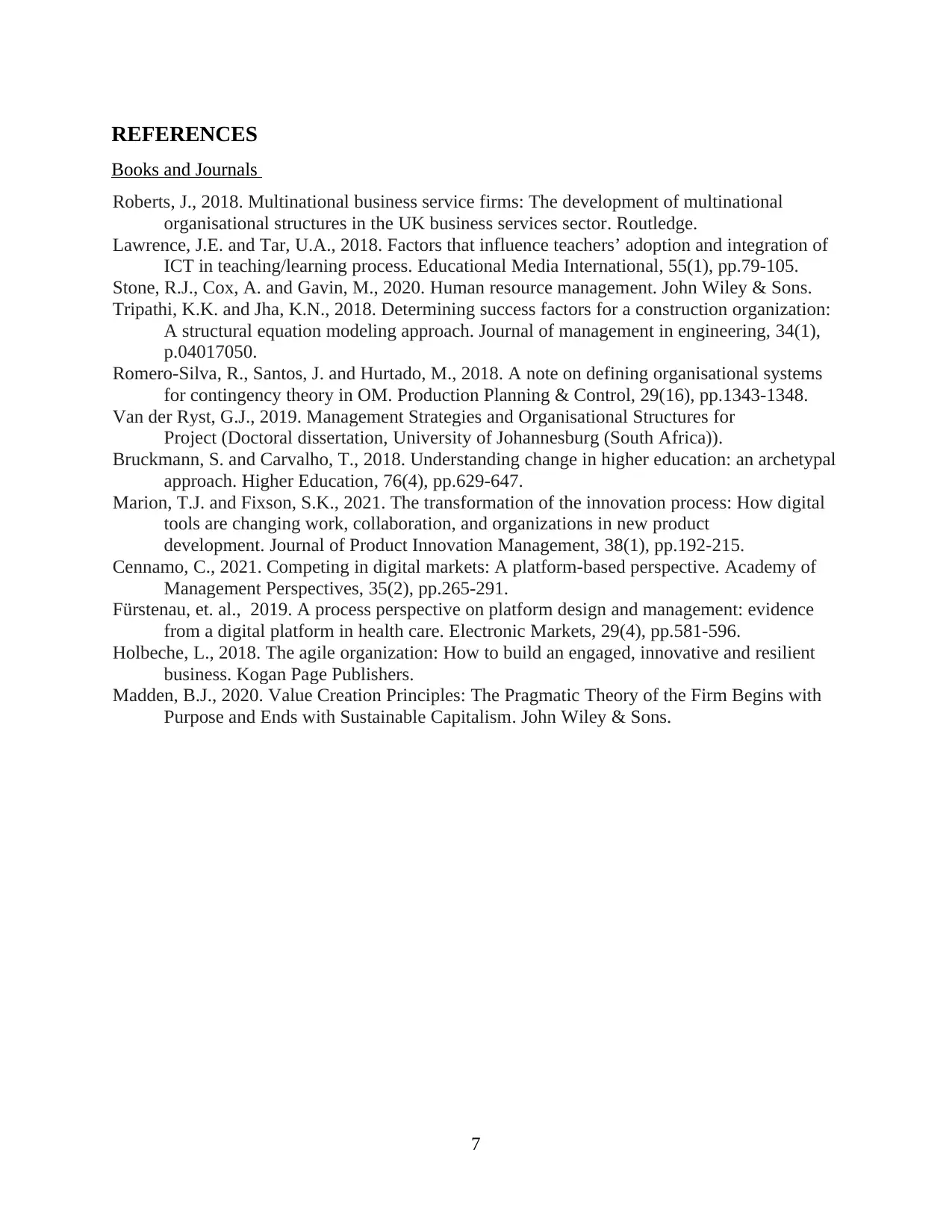
REFERENCES
Books and Journals
Roberts, J., 2018. Multinational business service firms: The development of multinational
organisational structures in the UK business services sector. Routledge.
Lawrence, J.E. and Tar, U.A., 2018. Factors that influence teachers’ adoption and integration of
ICT in teaching/learning process. Educational Media International, 55(1), pp.79-105.
Stone, R.J., Cox, A. and Gavin, M., 2020. Human resource management. John Wiley & Sons.
Tripathi, K.K. and Jha, K.N., 2018. Determining success factors for a construction organization:
A structural equation modeling approach. Journal of management in engineering, 34(1),
p.04017050.
Romero-Silva, R., Santos, J. and Hurtado, M., 2018. A note on defining organisational systems
for contingency theory in OM. Production Planning & Control, 29(16), pp.1343-1348.
Van der Ryst, G.J., 2019. Management Strategies and Organisational Structures for
Project (Doctoral dissertation, University of Johannesburg (South Africa)).
Bruckmann, S. and Carvalho, T., 2018. Understanding change in higher education: an archetypal
approach. Higher Education, 76(4), pp.629-647.
Marion, T.J. and Fixson, S.K., 2021. The transformation of the innovation process: How digital
tools are changing work, collaboration, and organizations in new product
development. Journal of Product Innovation Management, 38(1), pp.192-215.
Cennamo, C., 2021. Competing in digital markets: A platform-based perspective. Academy of
Management Perspectives, 35(2), pp.265-291.
Fürstenau, et. al., 2019. A process perspective on platform design and management: evidence
from a digital platform in health care. Electronic Markets, 29(4), pp.581-596.
Holbeche, L., 2018. The agile organization: How to build an engaged, innovative and resilient
business. Kogan Page Publishers.
Madden, B.J., 2020. Value Creation Principles: The Pragmatic Theory of the Firm Begins with
Purpose and Ends with Sustainable Capitalism. John Wiley & Sons.
7
Books and Journals
Roberts, J., 2018. Multinational business service firms: The development of multinational
organisational structures in the UK business services sector. Routledge.
Lawrence, J.E. and Tar, U.A., 2018. Factors that influence teachers’ adoption and integration of
ICT in teaching/learning process. Educational Media International, 55(1), pp.79-105.
Stone, R.J., Cox, A. and Gavin, M., 2020. Human resource management. John Wiley & Sons.
Tripathi, K.K. and Jha, K.N., 2018. Determining success factors for a construction organization:
A structural equation modeling approach. Journal of management in engineering, 34(1),
p.04017050.
Romero-Silva, R., Santos, J. and Hurtado, M., 2018. A note on defining organisational systems
for contingency theory in OM. Production Planning & Control, 29(16), pp.1343-1348.
Van der Ryst, G.J., 2019. Management Strategies and Organisational Structures for
Project (Doctoral dissertation, University of Johannesburg (South Africa)).
Bruckmann, S. and Carvalho, T., 2018. Understanding change in higher education: an archetypal
approach. Higher Education, 76(4), pp.629-647.
Marion, T.J. and Fixson, S.K., 2021. The transformation of the innovation process: How digital
tools are changing work, collaboration, and organizations in new product
development. Journal of Product Innovation Management, 38(1), pp.192-215.
Cennamo, C., 2021. Competing in digital markets: A platform-based perspective. Academy of
Management Perspectives, 35(2), pp.265-291.
Fürstenau, et. al., 2019. A process perspective on platform design and management: evidence
from a digital platform in health care. Electronic Markets, 29(4), pp.581-596.
Holbeche, L., 2018. The agile organization: How to build an engaged, innovative and resilient
business. Kogan Page Publishers.
Madden, B.J., 2020. Value Creation Principles: The Pragmatic Theory of the Firm Begins with
Purpose and Ends with Sustainable Capitalism. John Wiley & Sons.
7
⊘ This is a preview!⊘
Do you want full access?
Subscribe today to unlock all pages.

Trusted by 1+ million students worldwide

8
1 out of 10
Related Documents
Your All-in-One AI-Powered Toolkit for Academic Success.
+13062052269
info@desklib.com
Available 24*7 on WhatsApp / Email
![[object Object]](/_next/static/media/star-bottom.7253800d.svg)
Unlock your academic potential
Copyright © 2020–2025 A2Z Services. All Rights Reserved. Developed and managed by ZUCOL.




